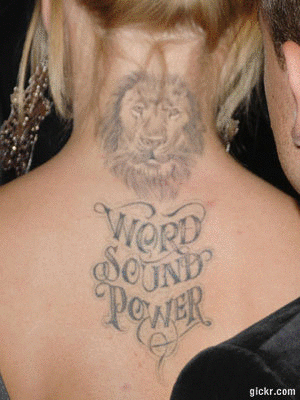Koi tattoo
 Many think that the the Koi fish originated in Persia, Eastern Asia and China. Wild carp are called Koi by many Japanese. The term itself was later applied to all carp, both wild and colored.
Many think that the the Koi fish originated in Persia, Eastern Asia and China. Wild carp are called Koi by many Japanese. The term itself was later applied to all carp, both wild and colored.
The Japanese now call the wild carp "magoi", and colored and inbred magoi are called Koi. Koi that are bred for color are called "Nishikigoi" which means colorful cloth (nishiki) and carp(goi). The depiction of the Koi fish is also one of the most popular and beautiful of the Japanese tattoo symbols.
Surprising to many Westerners is the large amount of ancient myth that surrounds the Koi fish and their elevated status in the Orient. Their glorious colors and color combinations may contribute to these tales. The colors include silver, gold, white, yellow, orange, black and even calico.
Some legends say that Koi fish can climb waterfalls bravely. They also say that if the fish has been caught, it will lay on the cutting board awaighting the knife without a quiver. In Koi symbolism this has been likened to a samurai warrior facing a sword.
This theme dates back to ancient China where a legend tells of how any Koi that succeeded in climbing the falls on the Yellow River at a point called Dragon Gate would be transformed into a dragon. Based on that legend the Koi became a symbol of worldly aspiration and advancement.
Eventually the fish came to be associated with so many masculine and positive qualities that it became Koi symbolism for the annual Boys' Day Festival in Japan. In this festival, colorful streaming Koi flags are traditionally displayed for each member of the family.
The various colors of the koi fish represent each of the family members. Black Koi symbolism stands for the father, the red and orange Koi symbolize the mother, blue-and-white Koi flags stand for the son and the red and pink Koi flags stand for the daughter.
In tattoo imagery, especially in combination with flowing water, the Koi fish symbolizes many of the same characteristics such as courage, the ability to attain high goals and the strength that enables one to overcome life's difficulties.
Many people are drawn to Koi fish art for the colors and meaning hidden within. Koi tattoos have become more popular in recent years. People believe that the placement of the fish on the human body is symbolic.
They think that if the Koi is swimming down the body it symbolizes that the person is trying to overcome hardship, while if it is swimming up the body it means that the person has already overcome many of the hardships in their life.
Buddhist monks say that humans "swim" through the "ocean of suffering" without fear like a fish swims through water. Thus, many people view the Koi fish as the symbol of how we should persevere in life. According to tattoo websites, Koi symbolism represents good fortune, prosperity and riches. Also the Japanese feel that the depiction of this fish on the human body represents male strength.
In Japan Koi symbolism represents perseverance in adversity and strength of purpose. The strongest Koi will swim upstream until it reaches the final waterfall where it vaults into the mists and becomes a water dragon.
Based on that legend the Koi has become a symbol of worldly aspiration and advancement. Because of its strength and determination to overcome obstacles it stands for courage and the ability to attain high goals.
Others say it means good luck and good fortune especially in China where seven golden Koi represent good luck. Another example of Koi symbolism is that the larger the Koi, the richer you are. This probably stems from the fact that large specimens are very expensive.
It has been said that if you are determined and don't conform to what society expects, you are like a Koi swimming upstream against the current. Koi symbolism represents yin and yang in ponds. Normally there is a balance of one black to nine gold.
Koi are referred to as "living jewels" or "swimming flowers". The positive attributes associated with Koi fish have made them popular choices for body art, jewelry and paintings for centuries. If you look into oriental art you'll find many beautiful examples of the Koi symbolism.












